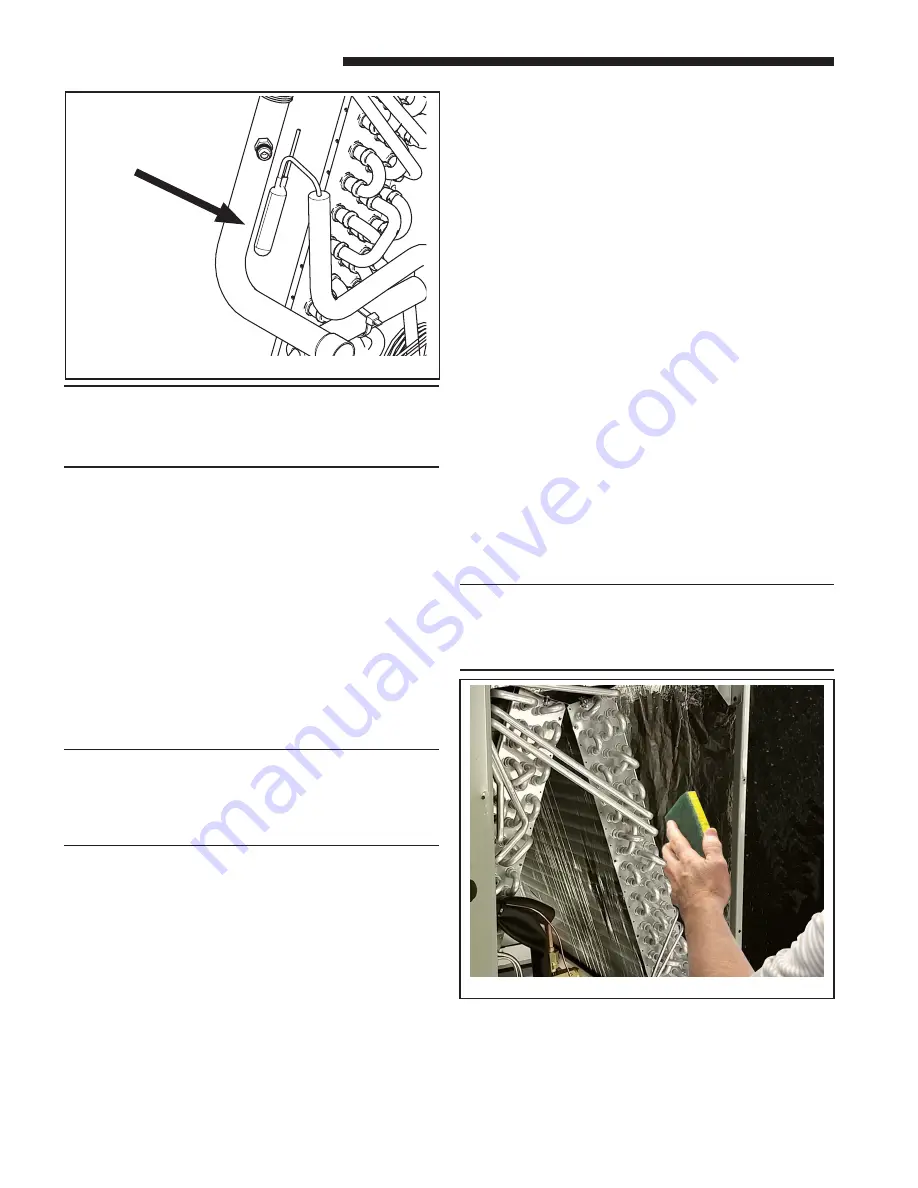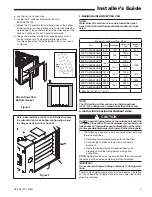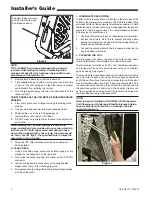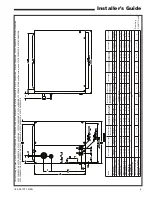
4
18-AD41D1-1B-EN
Installer’s Guide
NOTE:
TXV bulb MUST be protected (wrapped with wet rag) or
removed, while brazing the tubing. Overheating of the
sensing bulb will affect the functional characteristics and
performance of the comfort coil.
When replacing the TXV bulb, reinstall the bulb in the
proper orientation. Some models will use a spring steel clip
to attach the TXV bulb, and some models will use a hose
clamp. When supplied with a hose clamp, the clamp should
be "snug" but not "tight" - the specification is to torque the
hose clamp to 20 +/- 5 in-lbs.
H. LEAK CHECK
1. Using a manifold gauge, connect an external supply of dry
nitrogen to the gauge port on the liquid line.
2. Pressurize the connecting lines and indoor coil to 150 PSIG
maximum.
3. Leak check brazed line connections using soap bubbles.
Repair leaks (if any) after relieving pressure.
4. Evacuate and charge the system per the instructions packaged
with the outdoor unit.
Figure 7
J. CLEANING THE COIL
The two piece door allows removal of the outer casing doors
without interference from refrigerant or condensate lines.
The foil covered insulation on 4PXC coils should be wiped down
and residual dirt and dust should be vacuumed up to maintain
good air quality. See Figure 7.
The manufacturer’s recommendation for coil cleaning is to initially
use only water to wash away debris that may have collected on
and in the coil fin surface. Removing an evaporator coil is the best
way to effectively clean a coil that is heavily contaminated. This
is accomplished by removing the coil from the cabinet, sealing
the liquid and vapor line and using a strong water stream such
as from a garden hose, being careful to prevent fin damage. Use
chemical cleaners, only when necessary.
Figure 6
Capillary tubes will come
out the top of bulb when
positioned correctly.
I. CONDENSATE DRAIN PIPING
Condensate drain connections are located in the drain pan at the
bottom of the coil/enclosure assembly. The female threaded fitting
protrudes outside of the enclosure for external connection. A field
fabricated trap is not required for proper drainage due to the positive
pressure of the furnace; however, it is recommended to prevent
efficiency loss of conditioned air.
1. The drain hole in the drain pan must be cleared of all insulation.
2. Insulate the primary drain line to prevent sweating where
dew point temperatures may be met. (Optional depending on
climate and application needs)
3. Connect the secondary drain line to a separate drain line (no
trap is needed in this line).
PAINTED AREAS OF THE UNIT MUST BE SHIELDED DURING
BRAZING.
1. Remove both rubber plugs from the indoor coil.
2. Field supplied tubing should be cut square, round and free
of burrs at the connecting end. Clean the tubing to prevent
contaminants from entering the system.
3. Run the refrigerant tubing into the stub tube sockets of the
indoor unit coil.
4. Flow a small amount of nitrogen through the tubing while
brazing.
5. Use good brazing technique to make leakproof joints.
6. Minimize the use of sharp 90 degree bends.
7. Insulate the suction line and its fittings.
8. Do NOT allow un-insulated lines to come into contact with
each other.
9. Wrap the TXV with insulation after the hose clamp has
been installed.
NOTE:
Refer to Service Guideline, UN-SVG001C-EN, Evaporator
Coil Cleaning and Condensate Drain Maintenance Guide-
lines for important information on cleaning coils with
chemical treatments.


























